One very rewarding aspect of being a designer is connecting with other designers and being a part of a creative community. I love starting dialogues with the peers I admire most and learning about their inspirations, processes, projects and experiences. Nolen Niu, Patrick Norguet and Marc Thorpe are three unique and talented designers who I recently had the pleasure of talking with.
– Dan Golden
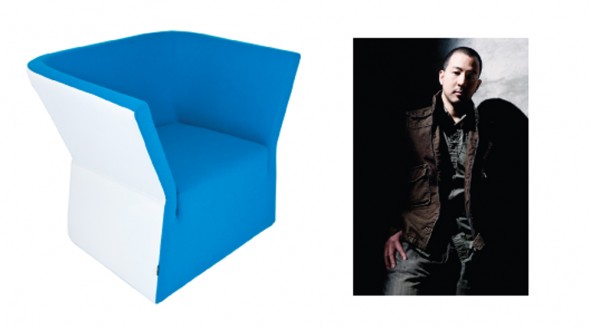
Nolen Niu is a Los Angeles-based furniture designer who is quickly emerging on the design scene. Nolen’s designs are bold, sophisticated and often playful. He has exhibited at the Salone de Mobil in Milan and at the International Contemporary Furniture Fair in New York. Nolen has also established his own local manufacturing network, allowing him to produce his own designs and operate outside of the traditional designer/manufacturer relationship when he chooses. His design talent, professionalism, entrepreneurial spirit and openness are admirable.
I enjoyed your booth at ICFF this year. It stood out as one of the best and tightest presentations in the entire exhibition. Would you talk a bit about your collection, your inspiration and your process? I’d love to hear about the overall experience/environment you wanted to create around your designs.
The 2010 collection was a departure from what we traditionally presented which were upholstered sofas. Like many companies in 2009, who took a hiatus because of the economic downturn, we look at the 2010 collection to widen our offerings with items that focused on volume, such as barstools and armchairs. The addition of wood and steel to our collection also allowed us to showcase new finishes previously not offered. In terms of overall experience, we really wanted our products to be graphic in presentation, using bold colors that were set on a clean canvas. Although our booth was simple, the main purpose was to highlight the products themselves.
You have also worked in corporate branding. I’m curious to hear how you approach the development of the “Nolen Niu” brand—how would you define what it is about, and how do you want it to develop in the future?
About eight years ago, I decided to focus on “Nolen Niu” as a brand versus having a company such as “Niu Designs.” I took notice that many American designers at that time created a brand and worked for it. Despite the fact that they might have been the head designer, their company would be the first thing recognized. Many European designers built brands of themselves. It was an approach I thought made the most sense because it did two things at once: it built brand recognition for both the designer’s work and for themselves. It was important then to establish “Nolen Niu” as not just a brand, but as a body of work that encompassed the brand. At the moment it is predominately furniture, but in the future I hope to include retail spaces and branding projects.
You were one of only two American designers that showed in a special exhibition at the Salone de Mobile a couple of years ago. Can you talk about the exhibition, about the experience and about its implications for your career?
The SaloneSatellite was a fantastic platform that gave you instant feedback on your work presented. The European community was very open and would express their likes and dislikes, which was extremely valuable. It was extraordinary to have this open dialogue with industry heavy weights and the general public, and was a fantastic gauge of where your work stood within the design community on an international level. Career wise, the pieces exhibited there were selected for the ICFF Studio Bernhardt Design exhibition in New York, which was pivotal to the launch of “Nolen Niu” as the brand, since it was there that the ZERO chaise lounge had its official debut.
Most designers design something, and wait and hope that a big manufacturer will produce it. You took a very pro-active approach and figured out a way to manufacture your own furniture designs independently. What is the impetus behind your decision to self-produce your own designs? What have been the most rewarding and most challenging aspects of doing this?
Having designed for a case goods manufacturer exclusively for more than seven years, my personal experience of the process felt slow in terms of product development. With royalties being the popular method of pay, you had to have a design that was either flying off the shelf or have hundreds of products on the market for it to be sufficient to sustain a career. When the opportunity presented itself for me to be able to manufacture on my own, I jumped at it immediately. The best aspect to this method, of course, is the ability to design and manufacture products on your own terms. This freedom to develop does come with its challenges since you are ultimately the one responsible for all the costs of prototyping, manufacturing, tradeshows, marketing collateral and the people to help manage that.
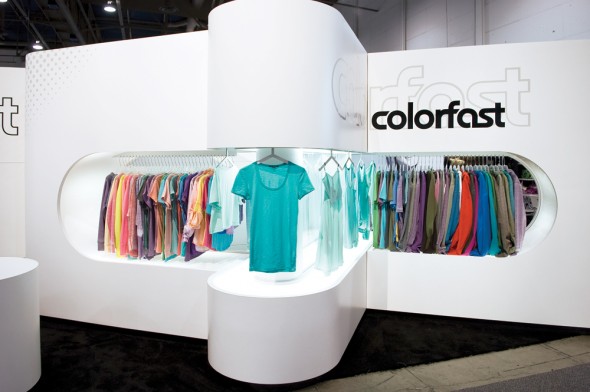
Colorfast tradeshow booth by Nolen Niu
Although you are currently producing your own collections, you are entertaining the idea of working with manufacturers in the near future. Can you list a few of the manufacturers that you admire and describe how they draw you in? How would you define your ideal manufacturing partner?
As for American manufacturers, Bernhardt Design has been incredible in terms of support since my participation in the ICFF Studio Bernhardt Design exhibition. Everyone at Bernhardt is always open to my questions and have been extremely generous with their knowledge and time. On the European side, I admire Plank and Moroso for their enthusiasm to test new boundaries. Plank has had some innovative products in the past few years combining technology with design, and I have enjoyed their product marketing, such as their limited edition books. With Moroso, I am fond of their fearless use of textures and colors, which sometimes blend fashion and art, creating visually stimulating, tactile pieces.
You are good friends with (and an occasional collaborator with) Marc Thorpe. You both seem focused on building a strong and supportive design community. Can you talk a bit about how you view the social aspect of design?
I have been very fortunate to have the opportunity to work with other designers who are very generous with their knowledge. I truly believe that having a solid network helps establish a support group and an environment for designers to grow and learn from. Also, I have been in situations where collaborations had benefited all parties involved with results that went well beyond the client’s expectations.
What are the things that are inspiring you right now?
The design studio side of my business, which focuses on corporate brand development, is currently working with a fashion apparel company called Colorfast, which I truly enjoy. We have been developing products together focusing on expanding their brand. We recently completed an innovative tradeshow booth design that featured a portable conveyor system, which we are planning to convert into a retail space concept.
For more info on Nolen Niu visit: www.nolenniu.com
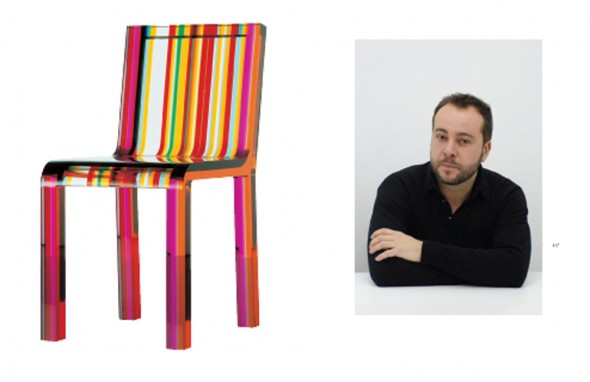
Patrick Norguet is a French designer whose designs seem both futuristic and classically modern. Patrick never seems to make a wrong design choice—whether he’s designing furniture or interiors, he maintains a high level of quality, sophistication and thought.
Can you talk about the development of your Rainbow Chair design for Cappellini in 2000, and what that design meant to you and your career when it was officially released?
The birth of the Rainbow Chair, designed in the late ‘90s, has enabled me to date the beginning of my work. This project was entirely handmade. From that presentation, Mr. Cappellini got in contact with me with the desire to sell the object. This project was before all work on transparency and color and material—a search for simplicity of design and drawing the archetype of a chair. Form does interest me—creating a remarkable object, the contrast between a form that is single file and a base for feet. For me it was very interesting to watch people’s reactions; this chair quickly earned the affection of a broad public. I think the strength of materials and the interplay of transparency with light and color speaks to many. This chair allowed me to enter the world of contemporary design.
I love your Boson Chair: it is futuristic, but also gives a nod to some of the great designers of the ‘50s. Can you talk about designers from the past that you particularly like?
In fact, I myself like this time of industrial history, after World War II. This is a very rich time: the birth of new technology, finding new philosophy, new ideological challenge again pushing the Western world for innovation and research. We were witnessing the birth of design and the emergence of people who will take the time to reflect and challenge these developments, for example, the work of Eames, photographs, films and furniture. I am also fascinated by the process and the work of Jean Prouvé; he retained throughout his career a taste for experimentation and attention to detail inherited from his training. I also appreciate George Nelson and his modernist principles.
I keep coming back to the point that your work seems both futuristic and classic. I’m curious to learn about the tools that you use. Pen and paper, I’m sure, which designers have always used, but what computer programs are a part of your process? What 3-D programs are you working with, and how are they changing the aesthetics of the products you are designing?
I draw a lot. Through drawing, my concept matures, and I build small models to accompany my drawings. From this stage, tools and technologies are used for project development as we work closely to create a three-dimensional object. I also like the optimization of new technologies as tools for research. I am working more with the group Dassault Systèmes, and am lucky to use the tools at the forefront of technology. But a good project to me will always be from design and research.
Your design for Plain Air is very unique. It’s an air purifier, but it looks more like a speaker, or a minimalist wall sculpture. How did that project develop?
Plain Air is the result of a four-year development with a small French company called TLV, and Philips. In a better world, this object would not exist; but unfortunately, we need to fight against the lack of human ethics and responsibility over the deterioration of our environment. Plain Air is therefore an object “prosthesis” destined to alleviate these problems. Once this fact was established, I had to integrate all these concepts into a simple object design, with a hollow, neutral, non-aggressive, poetic and sensual mouth for the air to come out, and a surface area to draw the air in and nothing more, but retain the idea that this object must have strong emotional capital. I hope that one day Plain Air will not be needed anymore.
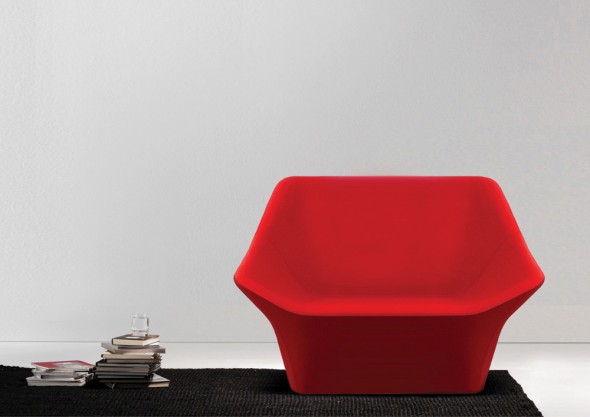
Rhea chair by Patrick Norguet
You have worked with a long list of manufacturers, so I’d like to learn more about some of the best relationships you have had. Can you define the qualities of your ideal manufacturing partners?
A good project is the result of a lot of love and trust between the designer and the manufacturer. I have worked long term with a few select companies, such as Lapalma and Offecct; we created real relationships that led to good results. I also like the companies Vitra and Axor. What fascinates me most about Vitra is not the image they create, but their ability to work with the designer. The company integrates the design and puts in the necessary research and development, investment, communication for success. I love the chance encounters in life, so I let them take me places, and who knows…
Can you list some of the things that inspire you or have inspired you?
Subconsciously, my creations are the result of experience, encounter, machinery, materials, feelings, the world of art, literature…I do not want to be influenced directionally. I am careful to keep my freedom and grow my own culture and critical sense. I think I am very sensitive to spaces and places that bring me the energy needed for research and creation. I love the sea and boats, mountains, areas of strength that demand humility.
In addition to product design, you also do interior design projects. I’m sure this keeps you busy. Do you have a team working with you? How do you manage all of these design projects?
Indeed, I have a team of designers who work with me. We are seven persons who take pleasure in developing large projects. I spend my time sketching possible future directions for objects, and we exchange ideas to achieve a unique direction—a process of “cleansing” to bring the best basic idea to the project. Making it difficult and wasting time is useless.
This development team formed naturally, because projects require a lot of work, follow-through and meetings. But I do not want to become a large structure because the quality of the project depends on the investment and time I spend on each project.
What is the primary underlying design objective that you bring to every project you work on? Do you have a specific design philosophy?
I do not like academics; life is not like that. What I know is that each project is the result of a unique history, exchange and different needs. I am always looking for simplicity. I do not like objects that distract for the wrong reasons, disrupting the atmosphere with their presence. I speak only through the object, trying to do fewer things, but better things, with it.
For more info on Patrick Norguet: www.patricknorguet.com
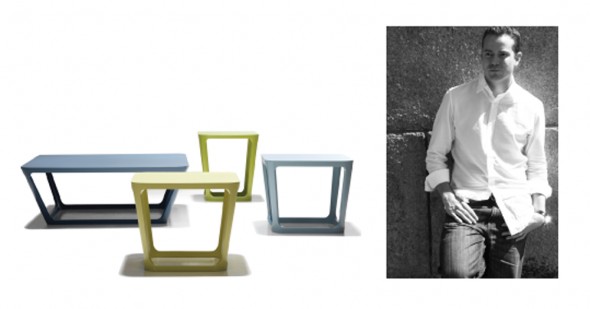
Marc A. Thorpe is the founder of Third Eye Studios (3E) New York, an architecture and industrial design cooperative. Independently, Marc has designed for top-tier manufacturers including Bernhardt Design, Moroso, and Quinze & Milan and teaches design at New York University. Recently, he added design curator to his list of accomplishments.
You’re very interested in building connections and relationships, bringing designers, ideas, companies and manufacturers together. How do you work? What is the philosophy behind Third Eye Studios?
I have always liked to speak about WE not ME. The notion of the solo “Architect” and “Designer” is dead. “Star Architects” and “Star Design” is bullshit. Life in itself is a series of interconnections, interactions and relationships. Architecture and design are a reflection of this, both in practice and in theory. My studio and myself act as a landscape of transition, an “event space” designed to enhance the evolutionary process of the becoming.
You recently helped organize the Kidrobot MunNY exhibit, in which a slew of designers reinterpreted Kidrobot’s Munny doll. How did the project originate?
The MunNY Exhibit was created by Joe Doucet, amazing NY designer, and Chad Philips, creative director at Kidrobot. Before the MunNY exhibit, Joe and myself began an ongoing conversation about the state of design in America and New York City that has brought together some of the brightest minds. Designers including Dror Benshetrit, Todd Bracher, Stephen Burks, David Weeks, to name a few, all participate in the talks. The Kidrobot MunNY exhibit was in many ways, born out of this dialogue.
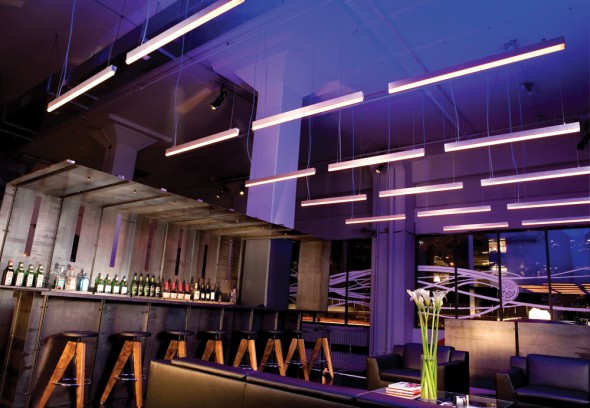
Classic Car Club in Brooklyn, designed by Third Eye Studios
You have designed products and spaces for Bernhardt Design, Moroso, Infiniti and Esquire among others. How do you choose which manufacturers to work with?
As a creative studio who finds its role in the built environment, with many social and cultural implications, it’s important to work with the right companies. We are very strategic when in comes to collaborating. We look for innovation, creativity, history, quality and above all, vision. It’s hard to find these qualities these days in corporate culture because vision in business requires a lot of risk.
Can you expand a bit on your approach as described on your site: understanding the dynamics of a given project and its “socio-cultural, political, financial and spatial limitations”?
In short, we don’t design products, furniture or buildings; we design relationships! What comes out of a new relationship is a formal or spatial bi-product. In essence, our designs are bi-products, not products. We don’t believe in design for design sake, there is too much of that these days—everyone hustling to be the next Starck. We believe in ideas that form relationships between the user and object, and vice versa. In fact, we are in many ways against designing and more interested in evolving.
Is there one area of your design practice that you would like to focus more on in the future? Or do you think where you are right now is a perfect fit?
We are a very forward-thinking studio, so to constantly engage the unknown is where I like to be; to evolve the standard definitions of what things are and push the status quo. However, at the same time, I like staying grounded in reality and being true to our fundamental principles of functionality, integrity and clarity.
Can you list some of the things that inspire you or have inspired you?
Life is inspirational for me, specifically I would say, films by Antonioni and Lynch; music by or music touched by Brian Eno; writer Franz Kafka; artists Tony Smith and Franz Kline; places such as Krakow, Firenze, Milan, Prague and Los Angeles; my favorite chair of all time is the Zig Zag by Rietveld; and I love those Dan Golden Rugs!
For more info on Marc A. Thorpe visit: www.3estudios.net

